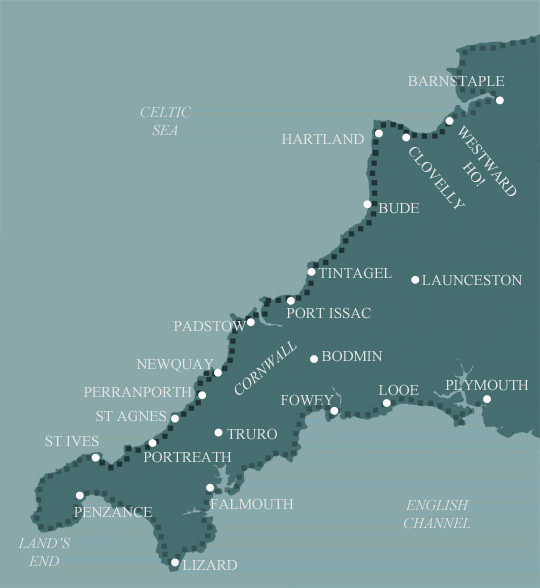North Cornwall Coast Path: Padstow to St Ives
Padstow to St Ives in 4 Days Walking Code: CNW5
We offer 2 itineraries from Padstow to St Ives. Hugging a rugged coastline, this route takes in golden bays, dramatic cliffs, and spectacular rock formations, before leading to the wildest and most exhilarating stretch of the entire path.
Walking from Padstow to St Ives over 4 days can be quite challenging in places, therefore this itinerary is better suited to stronger walkers.
| Miles | Km | ||
|---|---|---|---|
| Day 1 | Travel to Padstow for your first nights accommodation | ||
| Day 2 | Padstow to Porthcothan then transfer back to Padstow | 12 | 19 |
| Day 3 | Transfer back to Porthcothan and walk to Perranporth | 22 | 36 |
| Day 4 | Perranporth to Portreath | 11 | 18 |
| Day 5 | Portreath to St Ives | 18 | 29 |
| Day 6 | Depart from St Ives after breakfast |
Padstow to Porthcothan
Originally called Petrocstow, Padstow is the most sheltered and important harbour in the North of Cornwall. After spending your first night exploring Padstow’s fine restaurants the trail begins gently and eases you in to your day’s walk. Your first climb is at Stepper Point where you’ll pass the 19th century stone Daymark Tower, which was used as navigational tool by local sailors. The route then passes Butter Hole Cove, Gunver Head and then onto Harlyn Bay, the latter bay is famous for surfers and is home to a fascinating combination of rocky shoreline, sand dunes and tide pools to explore. Shortly after Harlyn Bay is Trevose Head which is the perfect spot for a picnic lunch next to the lighthouse. Your chance of spotting wildflowers increases on this section – particularly in May – and you may spot cornflowers, sea pinks and kidney vetch. Constantine Bay has a reputation as one of the best surf beaches in the area with one of the best swell pulls in Cornwall. The trail then leads you up and down over Pepper Cove, Warren Cove and Fox Cove until you descend into Porthcothan Bay.
Porthcothan to Perranporth
This section begins with a slow climb up to the clifftop towards Park Head and then onto Bedruthan Steps. The steps here are a geological wonder with magnificent views of the towering sea stacks. Whether the sea is calm or stormy this is an iconic and unforgettable view. Once you pass the Bedruthan Steps the impressive geology of the area can be a breath-taking experience. The trail then reaches Mawgan Porth which has a selection of cafés to stop for refreshments. A slight climb out of Mawgan Porth is followed with a minor descent towards Beacon Cove. You are then treated to glorious views from Griffin Point which is also home to an Iron Age fort. The trail then traverses round the clifftop at Watergate Bay which is a very popular spot for beach-goers, but due to tide times it is safer to stick to the clifftop path rather than the beach. Once you pass Trevelgue Head you can’t fail to notice the more urban scenery of Newquay. Newquay is one of the most popular spots for surfers in the UK and is famous for hosting several annual surfing events. The next few miles are quite a contrast from the clifftop paths but very interesting to explore. When you leave the busy surfing town of Newquay you have a few different options to cross the Gannel River onto the village of Crantock. There is a local ferry that runs in the summer months which crosses the Gannel River from Pentire to Crantock, or if you prefer to walk you can follow the trail and cross the river at the Laurie foot bridge at Trevemper. Upon leaving Crantock the next 8 miles are filled with wonderful coastal views but the trail on this section does include some sharp climbs up over the clifftops and down again. Perranporth is the largest settlement between Newquay and St Ives and is famous for its miles and miles of golden sands. It’s a popular spot for surfers and as the Perran beach is so long it can feel as if you have the whole beach to yourself.
Perranporth to Portreath
This section of the trail from Perranporth to Portreath is covered in heathland which once covered the whole of the west of Cornwall. This area is also a good spot for seal watching so keep your eyes peeled when you reach Newdowns Head. There are not too many climbs on this section which makes for some easier walking. The main climb on this section is at Chapel Point just after you pass St Agnes’s Head and the views here are outstanding. You’ll notice the former tin mine of Wheal Coastes on this section between Porthtowan and St Agnes. The former mines along this section are also home to the rare Greater Horseshoe bat. The next three miles from Porthtowan to Portreath are mainly alongside the Nancekuke military area where you need to traverse around its high fences. Even with these high fences in place, the views over the coastline are spectacular on your way into Portreath.
Portreath to St Ives
Leaving Portreath there is a slight climb out of the village but you will find the rest of this section to be fairly flat with only one main climb at Godrevy’s Point. In good weather you can spot Godrevy’s Island in the distance with Godrevy’s lighthouse from the clifftops. After climbing over the steepest part of this section at Godrevy’s Point you’ll notice the brightly coloured wildflowers such as primroses, blue sheep’s bit and yellow rattle – quite a contrast from the jagged reefs below. The coast path then follows along a vast sandy beach towards the town of Hayle. This was the first town in Cornwall to be awarded “Walkers Are Welcome” status which means the footpaths and trails around the town are well maintained and well-marked. Hayle is also famous for having Britain’s oldest swing bridges and was once the most important industrial port in Cornwall and a centre of copper mining and smelting. The Coast Path here also follows part of the ancient pilgrim route called St Michael’s Way which led pilgrims across Cornwall from Lelant to Marazion, near Penzance, where they would then travel on to the Cathedral of St James in Santiago de Compostela in north-west Spain. From Hayle you follow the railway line to St Ives, passing Carbis Bay and through the wooded outskirts of the town before arriving at the large, sheltered expanse of golden sand that is Porthminster Beach.
Moderate
Grades - This is not a technically difficult walk and should be easy to tackle for most reasonably fit people.
Terrain - The paths are good, and there are no major route finding challenges.
What’s it like underfoot? Generally good paths and tracks, although a few sections can get muddy after heavy rain.
How much up & down? – More than you’d think! Although you never reach more than 400m above sea level (and most of the time not more than 200m) there are many short steep sections. Most days involve ascents of 200-400m metres, although no section is very steep for very long.
Signposting: Good – the path is well waymarked.
Navigation: Pretty straightforward – good signposting, and generally well defined tracks.
Weather: You may be lucky enough to encounter warm, dry weather over the whole route and enjoy dry paths and tremendous views, but you must be prepared because the weather can change quickly. Good clothing and waterproofs are essential, but don’t forget you sunhat, sunblock and shorts!
|
All Holidays
|
|
| Accommodation | Overnight Bed and Breakfast accommodation in selected hotels, farmhouses, village inns, guest houses and family B&Bs. Full English or Continental breakfast. |
| Guidebook | A detailed guidebook with route information, maps, photos and background information. |
| Information of Services Along the Route | A comprehensive Service Info sheet, including services such as cash points, banks, post offices, village shops, inns, cafes and taxis. |
| Maps | A waterproof (1:40,000) Harvey Map covering the route. |
| Personal Itinerary | A personal itinerary setting out each overnight stop, including large scale maps of each accommodation, to ensure you find it easily. |
| Emergency Telephone Support | If you get in to difficulties during your holiday, we are always available to help, even out of office hours. |
|
Options
|
|
| Luggage Transport | We will transfer your luggage between each overnight stop if you leave your luggage at the accommodation when you set off in the morning, it will be moved on to your next B&B. You only need to carry a small day sack with the clothes and provisions you require during the day’s walk. |
| Packed Lunches |
We are unable to pre book packed lunches on this route. However, some accommodations will be happy to prepare a packed lunch if requested on arrival. |
| Off Road Parking | It is not possible to leave your car for the duration of the walk, the B&B’s do not have the space to allow long term parking. Please see the public transport tab for more information on travelling to and from the route. |
|
What’s not Included
|
|
| Evening Meals | Your evening meal isn’t included in the package, but we include full details and recommendations for each evening meal in your itinerary. You will normally be within walking distance of a pub and/or restaurant, or where there is good food available at the accommodation, we’ll book that for you. Allow about £30.00 per night. |
| Transport to the Start & Away from the Finish | Have a look at the ‘Travel Info’ tab above for suggestions. If you’re still struggling, get in touch and we’ll help you sort it out. |
| Travel Insurance | Even if you are based in the UK travel insurance is worth having. |
Good accommodation and friendly hosts are an essential part of any holiday. We understand this and go out of our way to find the best. We put a great deal of effort into hand picking our accommodation and matching it to individual customer requirements. As well as visiting the accommodation ourselves, we ask all our customers to complete a short evaluation on each night’s accommodation, which then gives us an insight into the day-to-day operation and lets us spot any potential issues before they become a problem.
We use a variety of accommodation. Over the course of your trip you might stay in a village inn, a bed and breakfast in a converted barn, a Victorian guest house, or on a working farm. In selecting the accommodation we look for helpful, friendly hosts with good quality, characterful accommodation close to the trail. Occasionally we may use a chain hotel.
We always try to arrange en suite accommodation, i.e. rooms with their own bathrooms for each night of your stay. However, in some of the more remote locations accommodation is limited and occasionally we may have to book rooms with shared bathrooms for one or two nights of your holiday, (especially if the booking is made at short notice), but we will always let you know if this is likely to be the case.
We are happy to book single rooms on our holidays but cannot normally book more than two for any one group. Single room bookings include a supplement.
Here are some examples of the accommodation we use on the North Cornwall Coast:
 The Wellington, a historic 16th-century coaching inn, overlooks Boscastle harbour from its charming hillside setting. This haven on Cornwall’s North Coast features 14 inviting bedrooms and a welcoming pub bar and restaurant serving delicious food and drink. Immerse yourself in Cornish history and folklore while enjoying a truly memorable escape. Visit their website
The Wellington, a historic 16th-century coaching inn, overlooks Boscastle harbour from its charming hillside setting. This haven on Cornwall’s North Coast features 14 inviting bedrooms and a welcoming pub bar and restaurant serving delicious food and drink. Immerse yourself in Cornish history and folklore while enjoying a truly memorable escape. Visit their website
 Bosayne Guest House, an Edwardian gem in Tintagel, offers a warm welcome amid stunning coastal scenery. Just a short walk from the village and coast path, it boasts beautiful Atlantic views. Guests enjoy a cosy lounge, a charming garden, and a delicious locally sourced breakfast, all in a designated Area of Outstanding Natural Beauty. Visit their website
Bosayne Guest House, an Edwardian gem in Tintagel, offers a warm welcome amid stunning coastal scenery. Just a short walk from the village and coast path, it boasts beautiful Atlantic views. Guests enjoy a cosy lounge, a charming garden, and a delicious locally sourced breakfast, all in a designated Area of Outstanding Natural Beauty. Visit their website
 Padstow Bed & Breakfast is perfectly positioned just a 10-minute walk from the historic Padstow harbour and its renowned dining, including Rick Stein’s and Paul Ainsworth’s restaurants. Guests enjoy two elegant en-suite rooms with super king-size beds, a spacious lounge, and a garden with outdoor seating. Visit their website
Padstow Bed & Breakfast is perfectly positioned just a 10-minute walk from the historic Padstow harbour and its renowned dining, including Rick Stein’s and Paul Ainsworth’s restaurants. Guests enjoy two elegant en-suite rooms with super king-size beds, a spacious lounge, and a garden with outdoor seating. Visit their website
 Painters Cottage in St Ives combines modern hospitality with the charm of an historic artist’s residence. This small, friendly guest house features four en suite bedrooms, blending Arts and Crafts period details with contemporary comforts. Ideally located, it’s perfect for exploring West Cornwall’s ancient landscapes and the South West Coast Path. Visit their website
Painters Cottage in St Ives combines modern hospitality with the charm of an historic artist’s residence. This small, friendly guest house features four en suite bedrooms, blending Arts and Crafts period details with contemporary comforts. Ideally located, it’s perfect for exploring West Cornwall’s ancient landscapes and the South West Coast Path. Visit their website
General Travel information for the South West Coastal Path will be in your holiday pack including train and bus timetables where available.
Detailed instructions on getting to your first night’s accommodation by car, or on foot from the nearest train or bus station, will also be included in the holiday pack on individual accommodation maps.
To view train times please visit trainline where you can also purchase tickets in advance. For information on bus timetables please visit traveline
Getting to Padstow:
By Air: The nearest and most convenient International Airports to the trail are any of the London Airports. Trains run hourly from London Paddington station direct to Bodmin Parkway (journey time approx. 4 hours) or to Newquay changing at Par (journey time approx. 5 hours).
Alternatively, you may wish to travel via Cornwall Airport Newquay (direct flights from Europe and connecting flights from London Gatwick). There is an hourly shuttlebus from Newquay Airport to Newquay Railway Station from where buses run direct between Newquay and Padstow (see below). You may also prefer to take a taxi from the airport (approx. 30 minutes – taxi office can be found within the terminal).
By Public Transport: The nearest railway stations to Padstow are Bodmin Parkway and Newquay. Plymouth Citybus service 11A runs hourly (every 2 hours on Sundays) between Bodmin Parkway Station and Padstow, journey time approx. 1 hour. First Kernow bus service A5 runs regularly between the Great Western Hotel, Newquay (2 min walk from Newquay Railway Station) and Padstow, journey time approx. 1 ½ hours.
By Road: Padstow is located at the end of the A389. Leave the M5 motorway just after Exeter at Junction 31 and join the A30. Continue on the A30 until you reach Bodmin then follow signs for the A389. Stay on the A389 as it passes through Bodmin then Wadebridge (where the A389 merges with the A39 for a short distance). At Wadebridge, follow signs for Padstow.
Returning from St Ives:
By Public Transport: There is a railway station at St Ives. St Ives station (SIV) is located at the end of the St Ives Bay branch line, off the Cornish Mainline at St Erth from where there are onward services throughout Cornwall and further afield to London (Paddington), Birmingham, Leeds and Edinburgh.
By Road: St Ives is located on the A3074, just off the A30 at Hayle. Leave the M5 motorway just after Exeter at Junction 31 and join the A30. The journey to St Ives will take approximately two hours. Continue on the A30 bypassing Hayle then follow signs for A3074 St Ives.
Padstow
Padstow is famous for its scrumptious seafood restaurants and its bustling harbour. One of Padstow’s highlights is the great variety of dining options which include a selection of the famous TV chef Rick Stein’s Seafood restaurants. Padstow has a lot to offer so it is best to book an extra night here to make the most of the town.
St Ives
A rest day in St Ives is a must when exploring the Cornish sights! Add an extra day to explore the picturesque fishing town with its narrow cobbled streets, quaint shops and restaurants. St Ives has an abundance of local artists and offers a wide range of galleries and museums to visit.
| Prices | GBP (£) |
|---|---|
| Accommodation, map & guidebook only | £675 |
| with Luggage Transport | £745 |
Other Options |
|
| Extra Nights (per night) | £95 |
| Single Supplement (per night) | £65 |
| Solo Luggage Supplement (per day) | £17 |
